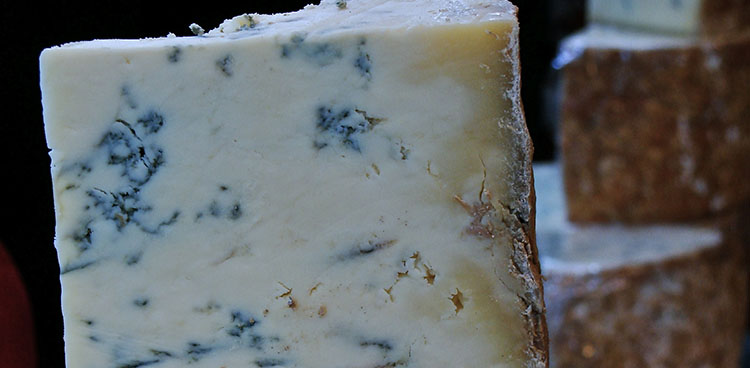
I have a confession: I’m a cheese blogger, and yet I can’t stand blue cheese. It’s not that I hate it and that I don’t want to like it — far from it. The fact is, I just can’t tolerate it. My stomach does not want to keep blue cheese down, no matter how hard I try, and for the longest time I tried to hide this fact. For someone who’s supposed to love cheese, it was embarrassing to say the least.
But there was one fateful cheese tasting that would break my best-kept secret. We were trying a pungent, intense cow’s milk blue, and after one sample I found myself running for the nearest trashcan. Previously I had been able to hold in my discomfort, but for some reason the strength of this one sample was enough to trigger digestive trouble that would last me the rest of the week. Nervously, I explained my predicament to my editor, expecting the worst for my future as a cheese blogger. Instead, she told me — quite supportively — that it was okay; some people can have allergies to the mold in blue cheese. That’s wonderful! I thought. Then I thought again. It’s not quite wonderful at all, really; but it’s not totally uncommon either, and it’s certainly not something to be worried about.
But how can we be allergic to moldy cheese? Furthermore, where does that sick-to-the-stomach feeling come from? We’ve all heard of mold allergies when spores are in the air – the main cause of those sniffles and sneezes during the winter months. On the other end of the allergy spectrum, some people can actually have more severe reactions from mold, resulting in anaphylaxis (swelling, the closing of the throat, etc.). Nestled in between the two is the digestive response: vomiting, diarrhea, and an upset stomach — each unpleasant in its own right. Each allergic response is similar in the way that your body engages with the mold, although the severity of that allergy dictates how you react, as well as the way in which the allergens enter your body.
Let’s take a moment to simplify allergies. When a foreign substance enters your body, it’s called an antigen — something that triggers an immune system response. Your immune system doesn’t like anything that doesn’t belong in the body, so it will instantly attack what it considers to be a threat. In some cases, like with bacteria and viruses, you’ll get a fever and the symptoms of the common cold. In other cases, your body will trigger the allergic responses previously mentioned. The antigens that trigger these are called allergens. When your body first encounters an allergen, it will make antibodies that seek out only that kind of foreign substance. If a match is found, the antibodies, attached to cells, will release a chemical, and that will cause you to sneeze, vomit, or swell up. In essence, each of these reactions is your body’s way of saying, “Get it out!” After all, in your immune system’s opinion, the allergens are not supposed to be there in the first place.
All foods have antigens, and mold is one of the most reactive allergens next to those found in nuts. Most varieties of mold are unsafe for human consumption (people already have the antibodies to respond to them). Because of this, the spores will often cause an immune system retaliation, with sneezes from airborne allergens and digestive turmoil if you dare to ingest it. That’s one of the reasons we use salt in our food — to deprive foreign organisms of the environment they need to grow. On the other hand, though, there are some types of mold that humans generally can eat — Geotrichum and Penicillium are two good types — and those are the types you often find on the rind of your cheese, or in the blue veins that run through paste (but beware, as bad mold can still grow on poorly kept cheese). Starter spores of these are often mixed in with the starter culture during cheesemaking; or, alternatively, they can be picked up from other cheeses when aging in a cave. Good mold is what ripens most cheeses, developing its flavor and changing its texture over time. Thus, it is considered absolutely necessary to cheesecraft along with the tools that promote the microorganism growth.
Even still, these good strains of mold can cause a whole slew of problems for some. Just as genetics gives us certain facial features and physical characteristics, they also give us different sets of antibodies than the next person. Therefore, while you might react to one antigen, most others might not have any immune response whatsoever. That’s why allergies affect different groups of people. As part of the mold subgroup, some people have allergies to specific types of spore. That’s where we get the Penicillin allergy — some people have antibodies that attack Penicillium mold. Reactions can range anywhere from hives and a skin rash to full on anaphylaxis – and somewhere in the middle, there’s nausea and Montezuma’s Revenge.
If you’re one of these few with a mold allergy, though, there’s still nothing to fear. Of course, the answer is to stay away from moldy cheese, but there are still plenty of fresh options out there for you to indulge. Do your research and check for starter cultures that don’t use mold spores, like in mozzarella and ricotta. And if you’re unsure about mold allergies, be sure to check with a doctor as they can easily run tests and tell you what to avoid. Of course, it’s never pleasant when these things catch you by surprise, but there’s always a way to work around them and still enjoy your favorite foods.
Feature Photo Credit: Julia Manzerova via Compfight cc



